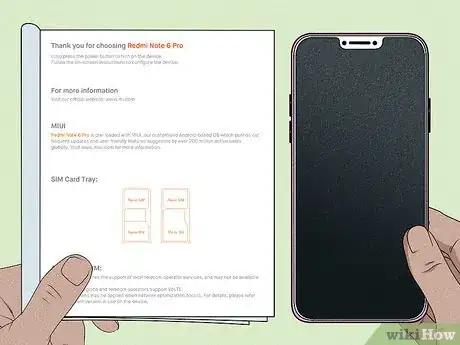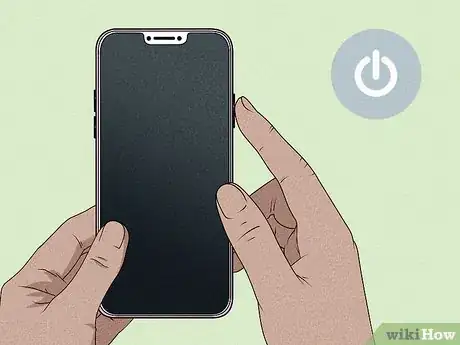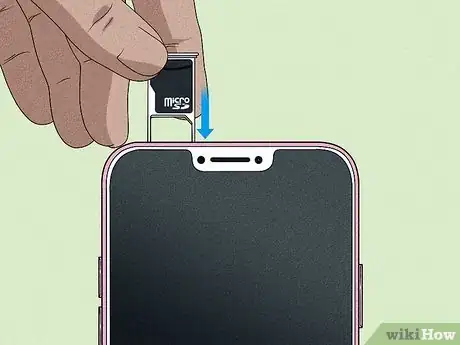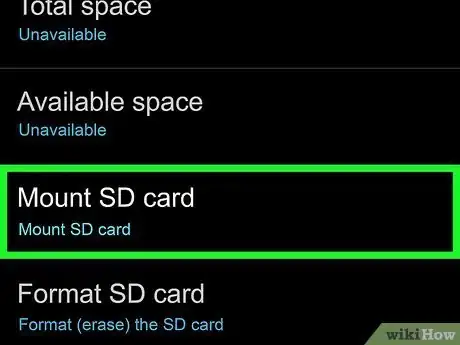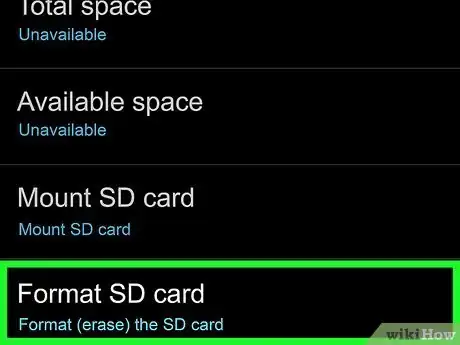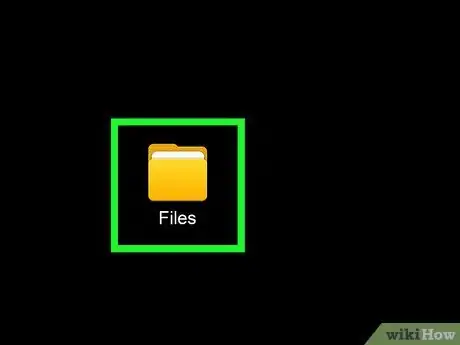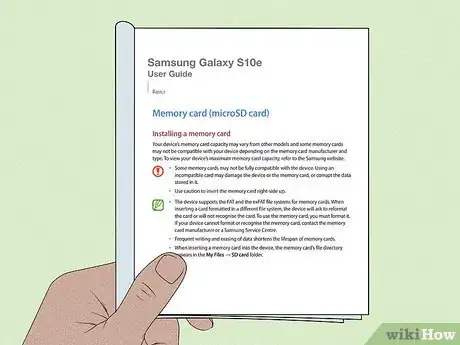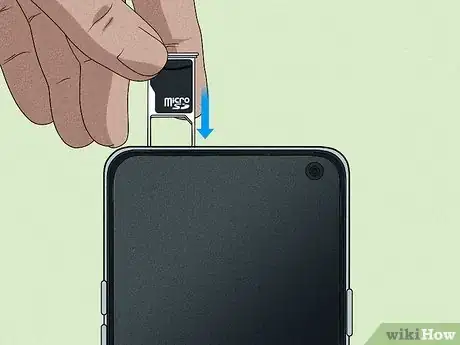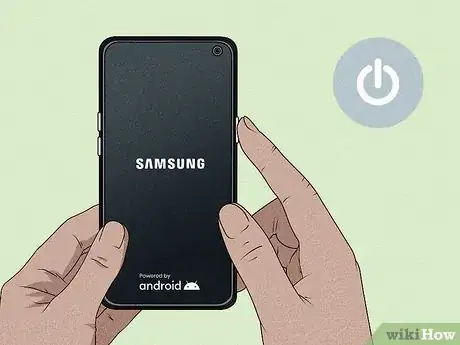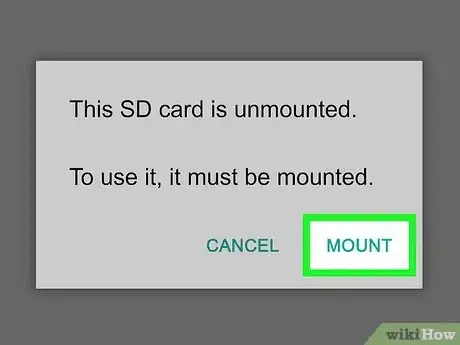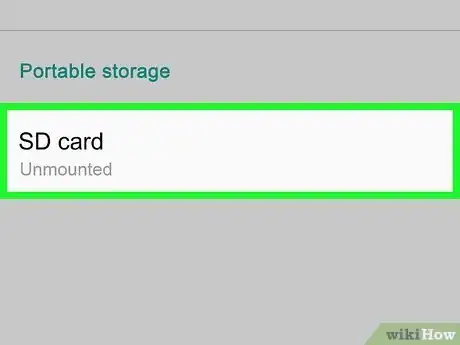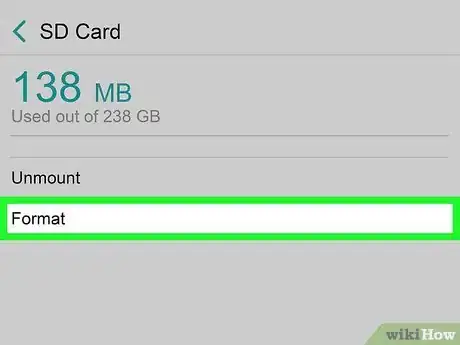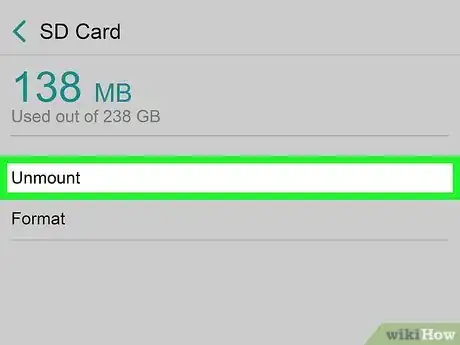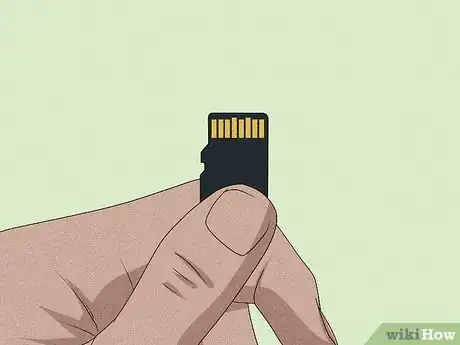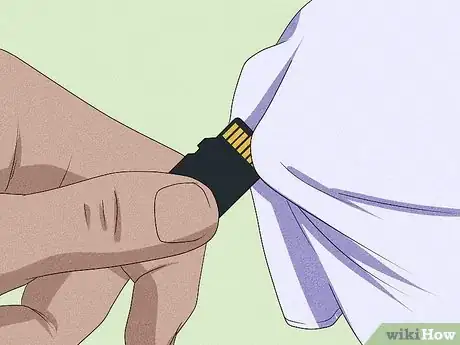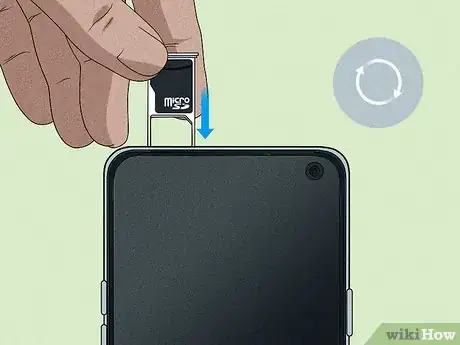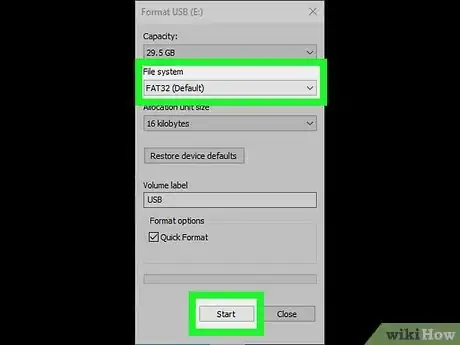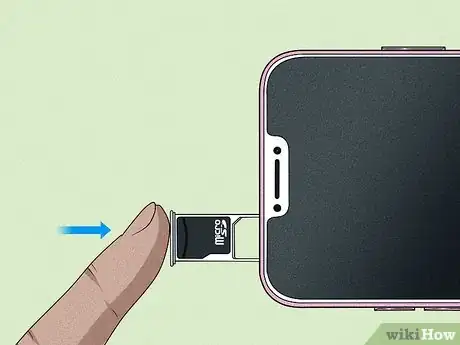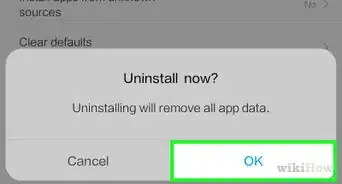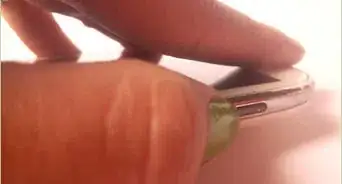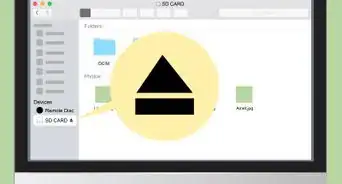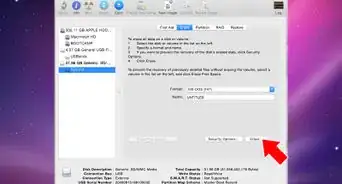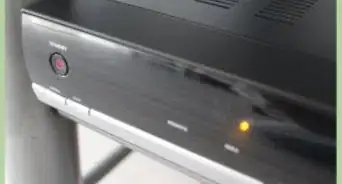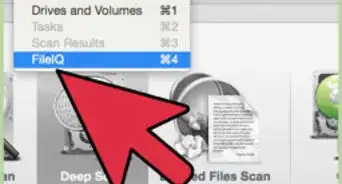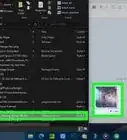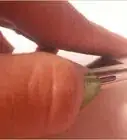This article was co-authored by Garnik Ovsepyan and by wikiHow staff writer, Travis Boylls. Garnik Ovsepyan is a Computer Specialist and the Owner of HeliX PC based in Burbank, California. With over 25 years of experience, Garnik specializes in custom computer builds, computer repairs, virus removal, computer tune-ups, hardware and software troubleshooting and installations, diagnostics, and data backup and recovery.
There are 8 references cited in this article, which can be found at the bottom of the page.
The wikiHow Tech Team also followed the article's instructions and verified that they work.
This article has been viewed 504,439 times.
Micro SD cards are high-capacity memory cards often used in phones and tablets. An SD card will become “mounted” to a device when that particular device recognizes the SD card and renders it accessible for use. Most devices will automatically mount an SD card after the card is inserted into the Micro SD card slot, but if you use an Android or Galaxy phone device, you can manually mount an SD card via the settings menu. If your device fails to mount an SD card, you must verify that there are no hardware issues with your device or with the SD card itself.
Steps
Mounting a Micro SD Card for Android Phones
-
1Check if your phone supports SD expansion. Many newer phones are trending away from the use of SD and MicroSD cards are extended storage. Check the user's manual or manufacturer's web page for your phone model to see if it supports SD cards.
- If your phone does not have SD card support, you can get extra storage using a cloud-based storage service like Google Drive.
-
2Power your phone off. To do so, press the power button on the right side of your phone. Then tap Power off. Tap Power Off again to turn off your phone.Advertisement
-
3Insert the Micro SD card into the SD card slot on your Android device. On most newer phones, the SD card is inserted in the SIM card tray. To install a SIM card, locate the SIM card tray on the side of the phone. It's a small oval-shaped compartment with a pinhole on the side. Insert a paperclip or the SIM card removal tool that came with your phone in the pinhole and press down to eject the SIM card tray. Place the SD card in the holder that's shaped like an SD card. Then reinsert the SD card back in the phone.[1]
-
4Power on your Android device. Press the power button on the side of your phone to power your phone back on. Wait for it to boot up.
-
5Tap Mount (if prompted). Many newer phones will mount your SD card automatically without giving your a prompt. Some phones ask if you want to mount your SD card. Tap Mount if prompted to mount your SD card.
-
6Mount the SD card manually. If the SD card has previously been unmounted or does not mount automatically, use the following steps to manually mount the SD card:
- Open the Settings menu.
- Tap SD and Phone Storage (maybe "'Storage and USB on some devices). .
- Tap Mount.
-
7Reformat and mount your SD card. If your phone does not recognize your SD card right away, you can format the SD card and then mount it. This will erase all data on the SD card. If there's any data on the SD card you want to keep, you may want to back it up on a PC first. Use the following steps to format and mount your SD card:[2]
- Open the Settings menu.
- Tap SD and Phone Storage (maybe "'Storage and USB on some devices).
- Tap Reformat below the SD card.
- Tap Mount when the SD card is finished formatting.
-
8Access the SD card using the Files app. You can access all files stored on the SD card using the Files app on your phone. If your phone does not have a Files app, you can download Files by Google for free from the Google Play Store.
Mounting an SD Card for Galaxy Phones
-
1Check if your phone supports SD expansion. Many newer phones are trending away from the use of SD and MicroSD cards are extended storage. Check the user's manual or manufacturer's web page for your phone model to see if it supports SD cards.
- If your phone does not have SD card support, you can get extra storage using a cloud-based storage service like Google Drive.
-
2Power your phone off. To do so, press the power button on the right side of your phone. Then tap Power off. Tap Power Off again to turn off your phone.
-
3Insert the Micro SD card into the SD card slot on your Android device. On most newer phones, the SD card is inserted in the SIM card tray. To install a SIM card, locate the SIM card tray on the side of the phone. It's a small oval-shaped compartment with a pinhole on the side. Insert a paperclip or the SIM card removal tool that came with your phone in the pinhole and press down to eject the SIM card tray. Place the SD card in the holder that's shaped like an SD card. Then reinsert the SD card back in the phone.[3]
-
4Turn your phone on. Press the button at the bottom of the phone. If your phone does not turn on, it is likely that it is out of power. Plug it into the wall charger for fifteen minutes and try again.[4]
-
5Tap Mount (if prompted). Many newer phones will mount your SD card automatically without giving your a prompt. Some phones ask if you want to mount your SD card. Tap Mount if prompted to mount your SD card.
-
6Mount the SD card manually. If the SD card has been previously unmounted or does not mount automatically, use the following steps to mount the SD card manually:
- Open the Settings menu.
- Tap Device care.
- Tap Storage.
- Tap SD card.
- Tap Mount.
-
7Reformat and mount your SD card. If your SD card does not mount automatically, you may need to reformat it and mount it. This will erase all previous data on the SD card. If there is any data you want to keep on the SD card, make sure you back it up to a PC. Use the following steps to format and mount your SD card:
- Open the Settings menu.
- Tap Device care.
- Tap Storage.
- Tap SD card.
- Tap Format.
- Tap SD card
- Tap Mount.
Checking for Hardware Problems
-
1Unmount and remount the SD card. If you are having problems accessing your SD card, use the following steps to unmount and remount the SD card and see if it fixes the problem:
- Open the Settings menu.
- Tap Storage or SD and Phone Storage (maybe be under Device care).
- Tap SD Card.
- Tap Unmount.
- Tap SD card
- Tap Mount.
-
2Remove the SD card and inspect for damage. Look for missing gold prongs. Check to make sure there aren't any dents or damaged areas of the SD card. [5]
-
3Clean the SD card. If the SD card appears dirty, you can clean it using a soft cloth and some lukewarm water or metal cleaner. Make sure the SD card is completely dry before reinserting it into your card.
-
4Attempt to mount the SD card again. After removing the SD card and inspecting it for damage and dirt, reinsert it back into your phone and attempt to remount it. Sometimes ejecting it and reinserting it fixes any problems it might be having.
-
5Reformat the SD card in exFAT or FAT32 format. If you have previously been used in a different device, it may be formatted in the wrong format. Warning: This will erase all data on the SD card. Insert the SD card into an SD card reader on a computer and then use the following steps to reformat the SD card in the correct format:
- Press Ctrl + E to open File Explorer.
- Click This PC.
- Right-click the SD card.
- Click Format.
- Select exFAT (recommended) or FAT32 below "File System."
- Click Start.
-
6Test the SD card in another device if it fails to mount properly. If the SD card works properly in another device, then your SD card slot may be faulty on the original device in which the card was tested. If the SD card fails to mount to another device, you may be required to replace the SD card.[6] Make sure before you put your Sd card into another device, that that device is also fully charged.[7]
Community Q&A
-
QuestionWill the files that are already stored on my SD card remain on the card when I move it to another phone?
 Community AnswerYes, the SD card will act exactly like a USB or hard drive. You should make sure that the new phone can read the files and have a file browser that will access them, but the files will absolutely still be on the SD card.
Community AnswerYes, the SD card will act exactly like a USB or hard drive. You should make sure that the new phone can read the files and have a file browser that will access them, but the files will absolutely still be on the SD card. -
QuestionHow do I keep my pictures safe?
 Community AnswerKeep a backup copy of your pictures online, using Google Drive, Dropbox, iCloud, or other such service.
Community AnswerKeep a backup copy of your pictures online, using Google Drive, Dropbox, iCloud, or other such service. -
QuestionHow do I fix an unexpectedly removed SD card error?
 Community AnswerPut it back in the computer and check if everything is there, then properly remove it by right clicking and selecting "eject."
Community AnswerPut it back in the computer and check if everything is there, then properly remove it by right clicking and selecting "eject."
Warnings
- Do not stick your finger or an object into the SD port in order to try and fix it. This will only cause more internal damage and require you to get a new phone altogether.⧼thumbs_response⧽
- Do not bend the card as you take it out of the SD port. You want to take it out slowly and methodically, avoiding any damage.⧼thumbs_response⧽
- Do not remove your SD card as it is in the process of dismounting, mounting, or reformatting. This will result in corrupt data, and make the card useless.[9]⧼thumbs_response⧽
References
- ↑ https://www.digitaltrends.com/mobile/microsd-card-android-guide/
- ↑ https://itstillworks.com/mount-sd-card-droid-9679.html
- ↑ https://www.samsung.com/sg/support/mobile-devices/how-to-install-or-remove-memory-card-in-samsung-mobile-device/
- ↑ http://www.howtogeek.com/216880/what-to-do-when-your-android-phone-or-tablet-won%E2%80%99t-turn-on/
- ↑ http://www.smartmobilephonesolutions.com/content/unmount-sd-card-android
- ↑ Garnik Ovsepyan. Computer Specialist. Expert Interview. 1 July 2021.
- ↑ http://visihow.com/Format_and_Mount_a_Samsung_Galaxy_S4's_External_SD_Memory_Card
- ↑ http://lifehacker.com/5584889/install-doubletwist-player-for-automatic-android-usb-mounting
- ↑ http://visihow.com/Format_and_Mount_a_Samsung_Galaxy_S4's_External_SD_Memory_Card
About This Article
1. Check to make sure your phone supports SD card storage.
2. Power your phone off and remove the SIM card tray.
3. Place the SD card in the proper slot in the SIM card tray and reinsert it.
4. Power your phone back on.
5. Tap Mount if prompted.
6. Open the Settings menu if the SD card does not mount automatically.
7. Locate the Storage menu in the Settings menu.
8. Tap SD card.
9. Tap Mount. For tips on mounting a micro SD card into an Android phone, read on!
